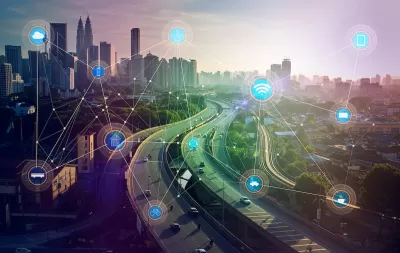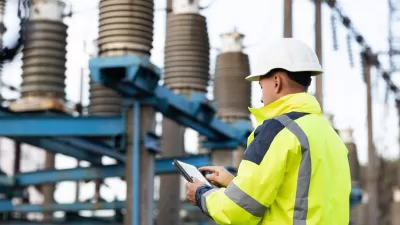By integrating technology and infrastructure, smart cities are attracting investors with their potential for improved quality of life, efficient resource management, and innovative urban development projects.

A smart city uses digital technology to enhance performance and well-being and reduce costs and resource consumption. It includes implementing Internet of Things (IoT) devices, advanced connectivity, and data analytics to improve urban infrastructure, services and quality of life.
The importance of smart cities in urban planning is growing. They offer innovative solutions to challenges like traffic congestion, energy management, and public safety, promoting sustainable development and improving the lives of citizens. They combine technology with urban planning to create more efficient, livable, and resilient cities.
Core concept of smart cities
Smart cities include three fundamental features—IoT, artificial intelligence (AI), and sustainable resources. For instance, IoT can optimize traffic flow through intelligent traffic lights, improve waste management with sensor-equipped bins, and enhance public safety with smart surveillance systems.
Meanwhile, AI makes predictive decisions, optimizes operations and provides personalized services to residents. It can predict traffic patterns, reduce energy consumption in buildings, and assist in emergency response by analyzing data trends.
Smart cities also emphasize using sustainable resources to reduce environmental impact and promote a healthier living environment. They use renewable energy sources and support the construction of green buildings and efficient waste management systems. These sustainable practices can reduce their carbon footprint and create a more sustainable urban ecosystem.
The impact of smart cities on real estate markets
Smart city initiatives profoundly impact real estate demand due to their advanced infrastructure, superior quality of life, and focus on future-ready developments. These cities attract residents and businesses seeking efficiency, connectivity, and sustainability, leading to increased demand for residential and commercial properties.
As a result, property values in smart cities often surpass those in traditional urban areas. Integrating high-tech solutions and sustainable practices creates a premium, with properties in these regions commanding higher prices due to the benefits and connected and sustainable living environment.
Singapore is a prime example, where the government’s $43.5 billion investment in sustainable infrastructure has significantly influenced its real estate market. This funding has led to developments in smart housing, efficient transportation, and green buildings, making the country a highly desirable location for living and investment.
Opportunities for real estate investors
Investing in smart city projects offers several potential benefits for investors. They often lead to increased property values due to their advanced infrastructure and enhanced quality of life, which can result in higher returns on investment.
The demand for housing and commercial spaces in smart cities is typically strong from residents and businesses seeking efficient, sustainable, and technologically advanced environments. This demand can lead to stable rental incomes for investors.
Moreover, U.S. investors can defer capital gains and depreciation recapture taxes when selling an investment property through the Internal Revenue Code Section 1031. This provision lets them reinvest the revenue from the sale into another “like-kind” property, deferring the payment of taxes until the sale of the newly acquired property.
Challenges and considerations
Smart city properties often require significant upfront capital due to the advanced technology and sustainable materials used in their construction. Additionally, navigating the complex landscape associated with the city’s development—such as compliance with new tech standards and environmental regulations—can be daunting for investors.
Urban planners must also balance tech-driven development and preserving community values. For instance, while smart cities rely heavily on technology for efficiency, ensuring this tech integration doesn’t compromise residents’ safety and well-being is essential.
A perfect example is the transmission delay from smart cards to external servers. A pause as slight as 100 milliseconds could result in an accident, underscoring the need for robust and reliable technology in smart city infrastructure.
Future trends and predictions
Emerging trends in smart city development—such as 5G networks, autonomous transportation and AI-driven urban management—are reshaping the real estate landscape. These advancements enhance the efficiency and appeal of smart cities, potentially increasing demand and property values. The smart city market volume is projected to exceed 165 billion by 2028, and these innovations will likely spur significant investment and create new real estate opportunities. Urban planners can integrate these technologies, ensuring developments align with sustainability and livability goals.
Uniting urban planners and investors for future cities
Urban planners and real estate investors must collaborate closely amid these dynamic changes. Together, they can harness the potential of smart city innovations for sustainable and profitable urban development. Moreover, they can ensure these developments incorporate cutting-edge technology and foster sustainable and efficient communities.

Maui's Vacation Rental Debate Turns Ugly
Verbal attacks, misinformation campaigns and fistfights plague a high-stakes debate to convert thousands of vacation rentals into long-term housing.

Planetizen Federal Action Tracker
A weekly monitor of how Trump’s orders and actions are impacting planners and planning in America.

Chicago’s Ghost Rails
Just beneath the surface of the modern city lie the remnants of its expansive early 20th-century streetcar system.

Bend, Oregon Zoning Reforms Prioritize Small-Scale Housing
The city altered its zoning code to allow multi-family housing and eliminated parking mandates citywide.

Amtrak Cutting Jobs, Funding to High-Speed Rail
The agency plans to cut 10 percent of its workforce and has confirmed it will not fund new high-speed rail projects.

LA Denies Basic Services to Unhoused Residents
The city has repeatedly failed to respond to requests for trash pickup at encampment sites, and eliminated a program that provided mobile showers and toilets.
Urban Design for Planners 1: Software Tools
This six-course series explores essential urban design concepts using open source software and equips planners with the tools they need to participate fully in the urban design process.
Planning for Universal Design
Learn the tools for implementing Universal Design in planning regulations.
planning NEXT
Appalachian Highlands Housing Partners
Mpact (founded as Rail~Volution)
City of Camden Redevelopment Agency
City of Astoria
City of Portland
City of Laramie






























